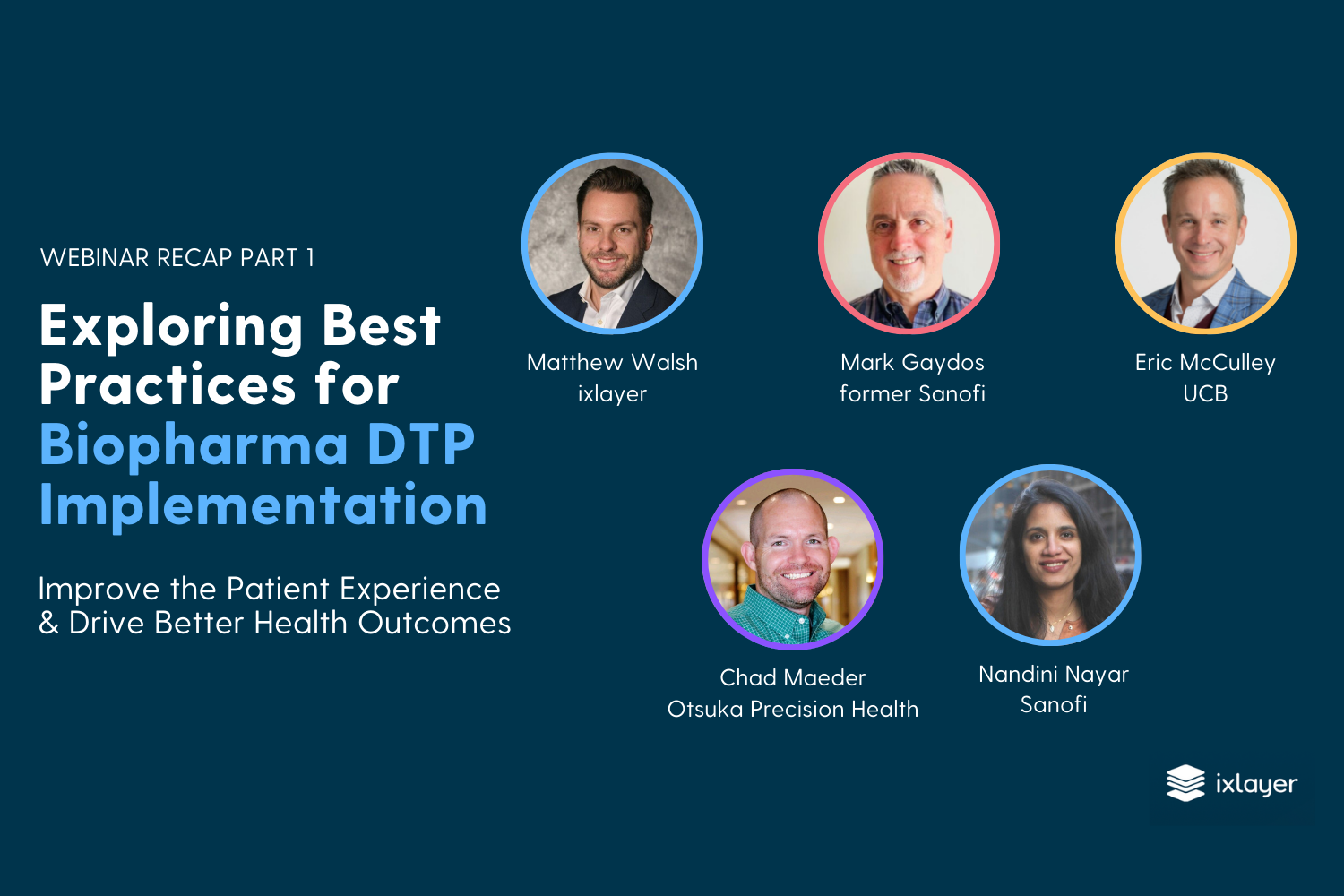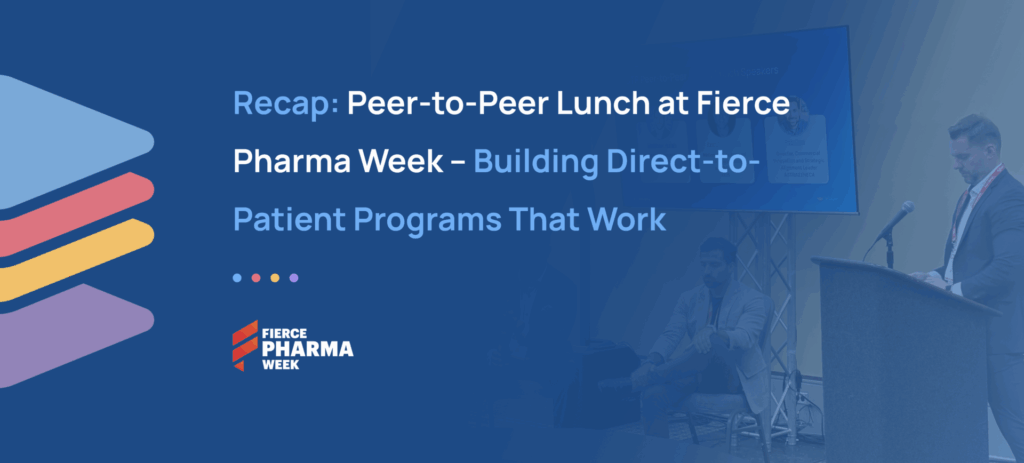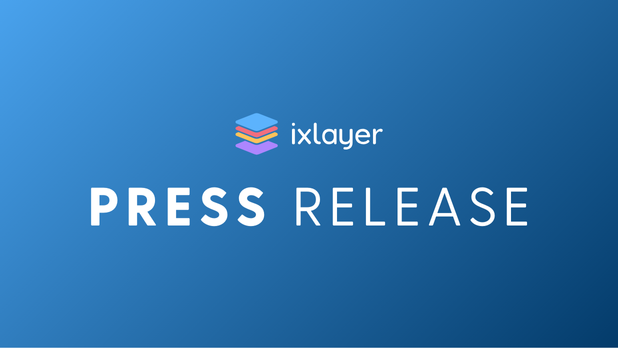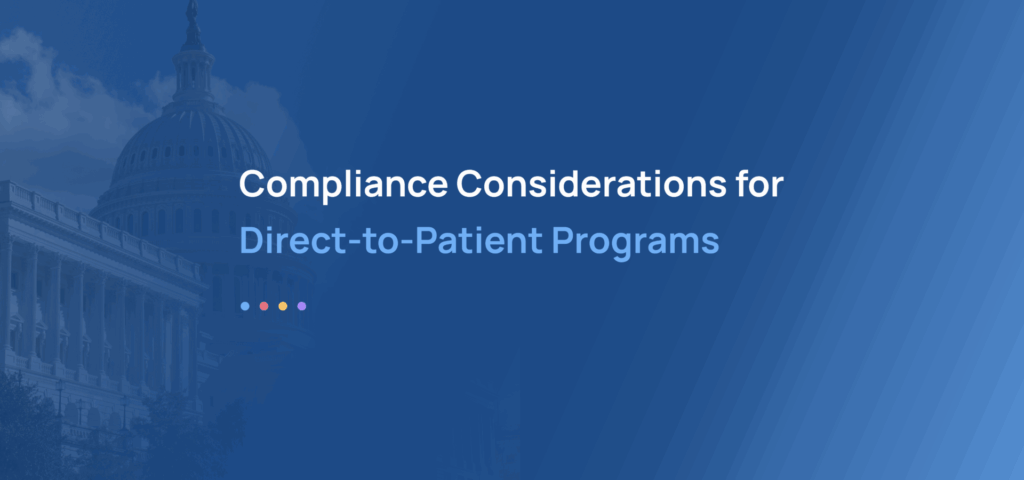Key Takeaways from Exploring Best Practices for Biopharma DTP Implementation – Part 1
ixlayer’s recent webinar in collaboration with The DHC Group, Exploring Best Practices for Biopharma DTP Implementation, clarifies the best practices and misconceptions around direct-to-patient (DTP) programs. The panelists addressed common myths, explaining how these programs operate and deliver impact, with a focus on understanding patients’ needs, the ways DTP supports early intervention and sustained care, and navigating compliance and implementation.
In our two-part blog series, we’ve recapped key takeaways from the webinar.
Part 1: Breaking Barriers—Transforming Biopharma’s Role with Direct-to-Patient Innovation
Direct-to-patient (DTP) programs have gained considerable momentum recently, signaling a transformative shift in biopharma’s approach to patient engagement and support. During a recent webinar, thought leaders from across the industry convened to explore best practices for DTP implementation, focusing on improving patient outcomes, addressing healthcare barriers, and reimagining how pharmaceutical companies interact with individuals.
The Patient-Centric Imperative
The webinar opened with a striking statistic: only 28% of patients believe pharmaceutical companies prioritize their needs.¹ Yet, 76% expressed interest in receiving help from these companies to alleviate healthcare barriers². This contrast underscores the untapped potential for biopharma to redefine its relationship with patients. As Chad Maeder, Senior Director, Patient Experience and Operations CNS/Neurology, Otsuka Precision Health remarked, pharma has “an opportunity to develop a partnership with the consumer. To transition from being seen as entities that just give medications to partners in my health experience.”
What is Direct-to-Patient?
Direct-to-patient is a well-used term, but its exact meaning can get muddled in with the initiatives of individual companies. Moderator Matthew Walsh, General Manager, Biopharma, at ixlayer, invited each panelist to define DTP for the industry as a whole.
“DTP to me is really about pharma stepping in to address some of the frictions and barriers to care that we’ve all experienced at some point,” said Nandini Nayar, Global Digital Health and Innovation Lead, Sanofi. “Why is pharma excited about this? There is now the technology and an ecosystem of players to help pharma move beyond their traditional remit and start to provide [more of] these wraparound services.”
Chad Maeder expanded on that adding that DTP is “allowing people to have a personalized health experience. It wraps in agility and comfort and convenience.”
Eric McCulley, Head of Portfolio Innovation, US Immunology, UCB went on to say that DTP is about how we put “patients at the center of the value chain.” There are a host of opportunities to build on that user experience, from getting patients streamlined access to treatments, increasing disease awareness and helping navigate the health journey for the patient.
Reimagining the Care Continuum
For many, the conversation around DTP has focused on prescription access. But, as Eric McCully explained, it’s so much more than that. “The needle continues to shift towards what we do squarely focused on the patient as our primary customer, not versus, but in addition to our HCPs. We’re trying to think more holistically before we even get to the prescription. How do we enable and empower patients to get to whatever that right prescription might be?”
Chad Maeder highlighted the importance of addressing access disparities. He noted that rural areas often face months-long waits for specialty care, leading to “medical deserts” where patients struggle to receive adequate treatment. Leveraging technology to connect patients with providers and resources can bridge this gap, creating a more inclusive healthcare system.
The providers are an integral part of this reimagining. As Mark Gaydos, a regulatory and compliance thought leader, formerly of Sanofi, pointed out, “The MD is still the one who prescribes. They decide with their patient, ‘This is the best course of therapy.’ DTP is there to help the patient gain access.”
Beyond Telehealth: Building Holistic Solutions
While telehealth has emerged as a cornerstone of DTP strategies, the panel emphasized the need to go further. Nandini Nayar discussed integrating monitoring tools between physician appointments like at-home lab testing or wearables to enable continuous care between clinic visits. “We have the technology to move beyond point-in-time assessments.” The challenge now is integrating these tools into workflows in ways that enhance both patient and provider experiences.
Chad Maeder expanded on this point, stressing the importance of simplifying patient journeys. The entry point matters. “Once the individual starts down the pathway, if there are numerous places where they have to submit information, sign up for things, click through to other modalities to get access to care—that’s a deterrent. For most of us, it’s a deterrent to signing up for anything. How do we smooth out the entrance? How do we make it as simplistic as possible so the experience delivered is very easy?” If signing up or navigating services feels cumbersome, patients won’t engage. Every touchpoint needs to be smooth to ensure care is as accessible as possible.
The Industry’s Role in Collaboration
An essential theme throughout the webinar was collaboration. Nandini Nayar advocated for a “rising tide lifts all boats” approach, encouraging companies to work together to address systemic barriers. It’s not about competing for patients but collectively building solutions that improve access and outcomes.
As DTP models evolve, industry leaders must balance altruistic goals with practical considerations. Eric McCulley emphasized the need for a shared vision: “Let’s try to step out of this idea that we have a sandbox in a therapeutic area. Let’s elevate the thought, then the practical application, lock arms across the industry with our HCPs and let our patients drive what matters most to them.” If life science organizations can align on long-term objectives, it will unlock innovations that benefit everyone—patients, providers, and the biopharma industry alike.
Stay tuned for Part 2, where we’ll dive into compliance considerations, evolving market dynamics, and the future of direct-to-patient care.
CLICK HERE to learn more about how ixlayer works with biopharma leaders to integrate a complete end-to-end, direct-to-patient experience into their marketing campaigns.
References
- Source: ixlayer/Ipsos Proprietary Research Survey, Jan 2025, early-read directional results, n=106
- ibid
About ixlayer
ixlayer is the only end-to-end, direct-to-patient platform built for biopharma and optimized for patient choice. We help biopharma companies connect with patients from testing to treatment with speed, transparency, control and impact.







